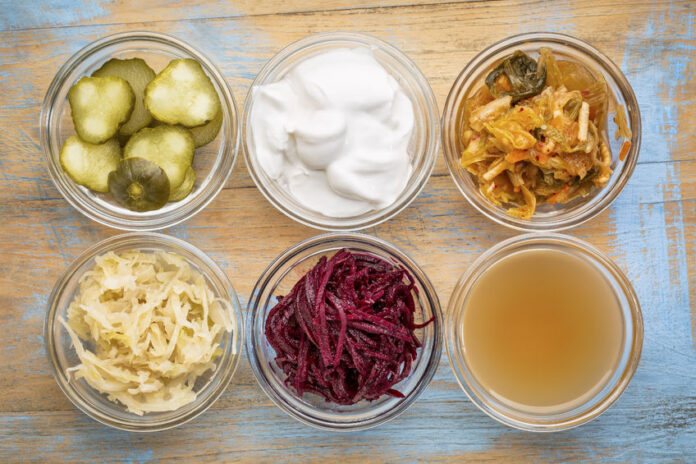
By Chef Deborah Lieder
 Once upon a time, in the land of food, it was common practice to preserve the bounty, whether dairy, vegetables or meats. What is now known as fermentation, is a practice that is being removed from our daily lives and commercialized, like most old world practices. And hence, the benefits seem to be forgotten. You see, fermentation is what gives us a happy, healthy gut. It allows our body to absorb nutrients better, dispel toxins correctly, and keeps the digestive system working properly. Our digestion and emotions are directly linked and are governed by our Solar Plexus chakra. The Solar Plexus deals with our personal empowerment, and if you notice, how we choose to eat reflects how we feel about ourselves.
Once upon a time, in the land of food, it was common practice to preserve the bounty, whether dairy, vegetables or meats. What is now known as fermentation, is a practice that is being removed from our daily lives and commercialized, like most old world practices. And hence, the benefits seem to be forgotten. You see, fermentation is what gives us a happy, healthy gut. It allows our body to absorb nutrients better, dispel toxins correctly, and keeps the digestive system working properly. Our digestion and emotions are directly linked and are governed by our Solar Plexus chakra. The Solar Plexus deals with our personal empowerment, and if you notice, how we choose to eat reflects how we feel about ourselves.
A healthy gut is so important now-a-days because it can easily be destroyed. Through antibiotics, over the counter medications, herbicides and pesticides, artificial food coloring, and sugar (to name a few) can wipe out our whole colony of healthy gut flora. Over time, this leads to some serious diseases such as diabetes, IBS, obesity, liver disease, heart disease, autism, and cancers. And the truth is, it is not our fault; as we commercialize and process foods, the value of nutrition and education of becomes lost.
Thankfully, there is a resurgence of interest in these old world practices that benefit our health. Any fermented product restores the gut flora. Ferments include apple cider vinegar, kombucha, yoghurt, fermented coffee, fermented vegetables, kefir, miso, and beet kvass and many more. Research has shown that 1 quart of sauerkraut is equivalent to 16 bottles of probiotics! Probiotics can cost upwards of $40 a bottle versus only a few dollars and a little bit of time to make sauerkraut at home. If you purchase from the store, make sure to buy unpasteurized, usually located in the refrigerated section, as pasteurization will kill probiotics. The simple addition of fermented products into your diet can skyrocket your body to a happy, healthy gut!
Sauerkraut
1 head of cabbage
2-4 T. Salt, preferably Celtic Sea Salt or Himalayan
Filtered Water
Jars for Canning
Shred the head of cabbage into small pieces and place in a bowl. Salt to taste – if you like less salty food, go with 2 T, and for saltier 4 T. I use 2.5 T per quart. Massage cabbage until juice releases. You can also use a tamper. Or, after you salt the cabbage, simply place a plate with a heavy weighted object on top to press the juice out. If using this method, it takes about an hour or two for juice the press out. Pack your cabbage and juice into your jar.
Better flavor comes from the sauerkraut using its own juices to ferment. If the liquid does not cover the cabbage, add filtered water to the lip. Make sure to leave 2” at the top. To ensure cabbage is submerged, use fermentation weight or reserve a piece of the “butt” of the cabbage (area by the core where cabbage is the stiffest) that is larger than the jar mouth to keep submerged. Cover jar with lid or coffee filter and rubber band and culture at room temperature for 2 weeks. If using a tight lid, “burp” daily to release excess pressure. Once complete, seal with a tight lid and move to cold storage, a basement or cellar. The longer the sauerkraut sits, the more flavor it will develop.
Fermented Vegetables
Vegetables of Choice:
Carrot, garlic, peppers, kohlrabi, beets, radish, turnips, apples
Herbs and Spice
Salt
Filtered Water
Cut vegetables in the way preferred. The larger the cut, the longer the ferment. Add herbs and spice accordingly. Feel free to play around with your combinations! Make sure to label your jars! Add salt and filtered water to cover. Make sure vegetables are submerged in water using a weight or butt of the cabbage. Leave 2” space at the top. Cover jar with lid or coffee filter and rubber band and culture at room temperature for 2 weeks. If using a tight lid, “burb” daily to release excess pressure. Once complete, seal with a tight lid and move to cold storage, a basement or cellar. The longer the vegetables sit, the more flavor it will develop.
Chef Deborah Lieder
For more information visit her website: www.deborahlieder.com or contact Chef Deborah personally at: 248-974-5696 and by email at deborahlieder@aol.com.










